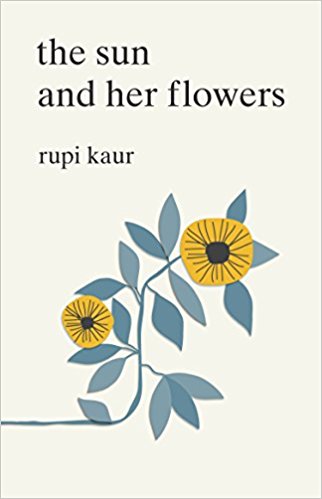Rupi Kaur releases new book of poems
“the sun and her flowers” grows in popularity

Fair use from Simon & Schuster.
January 8, 2018
No. 1 New York Times bestseller and illustrator Rupi Kaur is back again with her most recent book, “the sun and her flowers,” another collection of self-written poems.
Kaur released her first book, “milk and honey,” in 2015, which addressed love, loss, trauma, abuse, healing and femininity. “the sun and her flowers,” released this October, continues this trend of themes plus topics of abandonment and empowering one’s self.
The book is divided into five chapters of poems relating to an overarching subject. This format is similar to her previous collection of poems “milk and honey,” but is different in that Kaur includes the concept of flowers in every chapter.
The book’s first chapter, “wilting,” deals with issues of abandonment and self-hate. In “the sun and her flowers,” the themes are more subdued compared to the serious yet equally important topics of abuse and rape written in her previous novel. Though the poem’s main messages to readers are about becoming broken from others actions and feeling lost with yourself, Kaur’s use of only lowercase letters in her poetry contribute to the novel’s mundane and simple tone, fitting for the poetic content.
The second chapter, “falling,” includes poems and illustrations dealing with moments of loss and confusion, especially the roadblocks of life. The illustrations Kaur uses to create visuals of the message she hopes to send to readers help to provide a better look of experiences Kaur may have faced herself. Drawings of crowded people and empty bodies truly reflect the themes of this chapter, foreshadowing what will come next throughout the following chapters. The use of illustrations alongside her poems allows more serious topics to feel welcoming and open for conversation, since they aren’t always addressed in society today.
“rooting,” the third chapter in the collection, incorporates poems surrounding ideas of where people come from and tying problems society faces today to their original roots. Confronting topics such as terrorist attacks, immigration and divisions of rights allow readers to tie poetry with situations they may see and face in their everyday lives. The lack of illustrations is due to the poems’ serious and grim subject matter. This chapter provides a layer of further depth to Kaur’s typically raw and real poetry.
Her fourth chapter, “rising,” discusses love, opening up and new beginnings. This chapter especially connects with a male audience, questioning masculinity and standing with the equality for both women and men. Kaur’s poems continue her trend of the importance of opening up to other and how being emotional is okay, no matter what kind of person you may be. Kaur uses the tagline where poets usually credit themselves in creative ways throughout her previous poetry collections. This novel especially creates a gateway with these taglines to the perspectives of Kaur and her own experiences in life she has faced. “rising” creates a wonderful and uplifting sensation for readers who may feel connected with issues mentioned in the previous chapters of the collection.
The fifth and final chapter “blooming” metaphorically relates the theme of flowers to literal and figurative personal growth. These poems range from extensive 20 line poems to ones as simple as one line. Both formats express meaningful messages that connect with readers in a beautiful way. The illustrations connected with these poems specifically connect frequently with nature, amplifying the continuous theme of growth and starting anew. Her final chapter creates an outstanding conclusion to “the sun and her flowers,” demonstrating a hope for readers despite all the troubles they may face along the way.
“the sun and her flowers” creates a beautiful ambiance for readers to enjoy poetry in a raw and real format. Kaur’s ability to spread wonderful and important messages will directly connect with readers and their interest in the novel. Spreading the message of, Kaur urges readers to face the struggles of life in order to gain acceptance and bloom like a flower.
For students who connect with poetry and written verses in general, “the sun and her flowers” can be purchased online or in stores at Target and Barnes and Noble.



